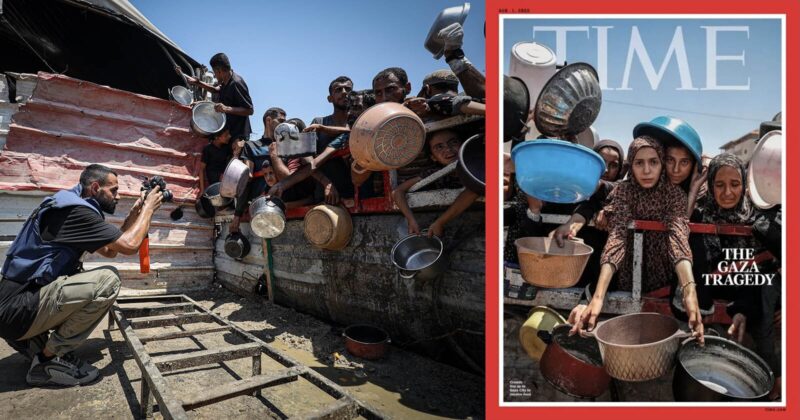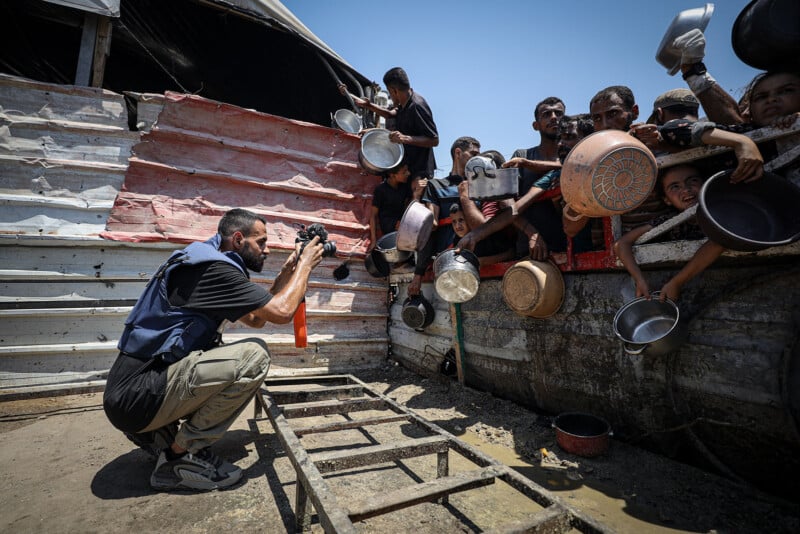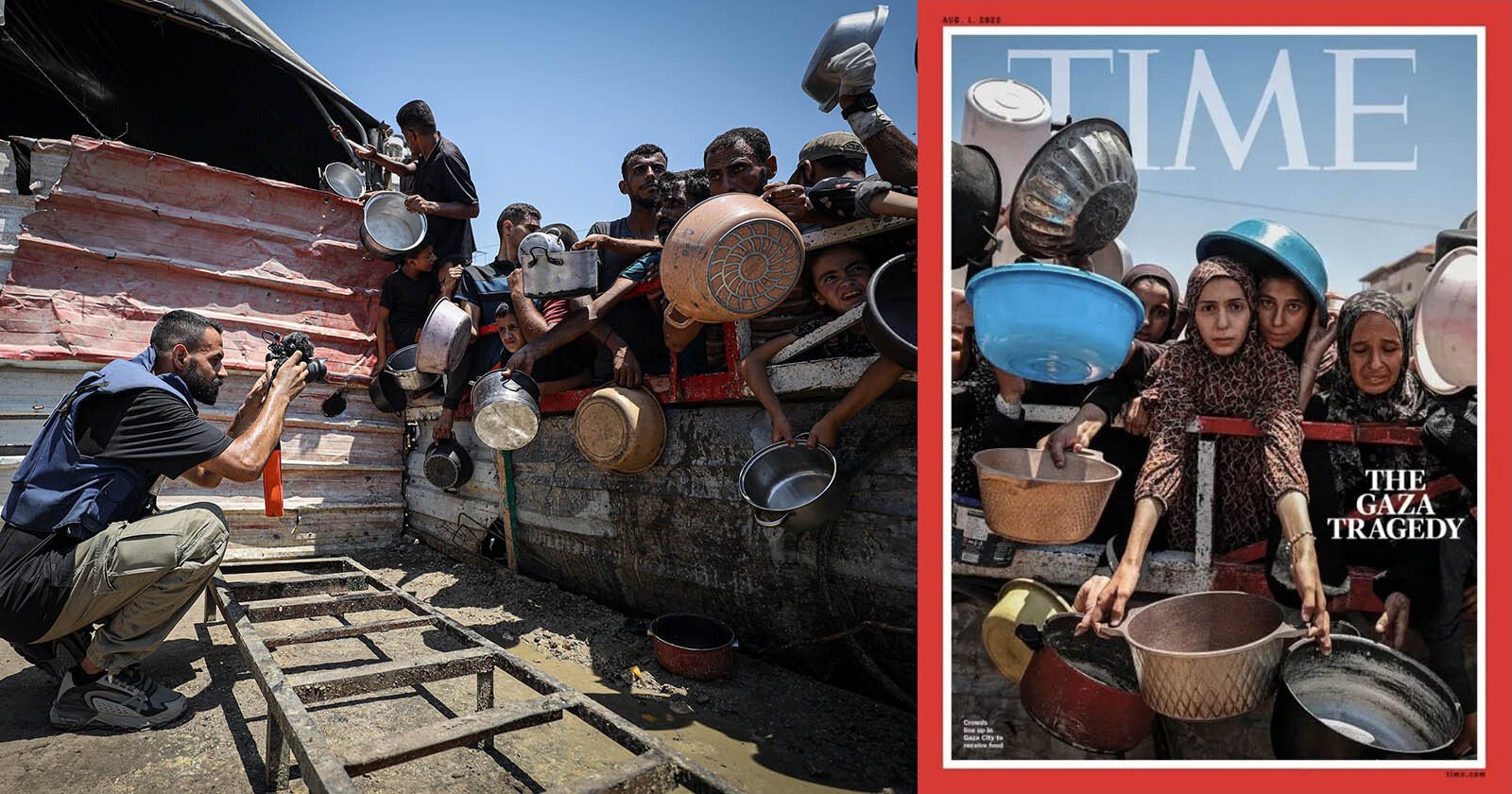 Left: GAZA CITY, GAZA – JULY 24: Anadolu freelance photojournalist Anas Zeyad Fteha documents the struggle of displaced Palestinians to access food, while often facing hunger himself as Anadolu freelance journalists continue their work under difficult conditions to shed light on the humanitarian impact of Israeli attacks on Gaza on July 24, 2025. | Photo by Khames Alrefi/Anadolu via Getty Images.
Left: GAZA CITY, GAZA – JULY 24: Anadolu freelance photojournalist Anas Zeyad Fteha documents the struggle of displaced Palestinians to access food, while often facing hunger himself as Anadolu freelance journalists continue their work under difficult conditions to shed light on the humanitarian impact of Israeli attacks on Gaza on July 24, 2025. | Photo by Khames Alrefi/Anadolu via Getty Images.
Right: Time magazine cover, August 1, 2025. | Photo by Ali Jadallah for Anadolu via Getty Images.
The images of starving Palestinians coming out of Gaza carry significant emotional and political power throughout the world. However, recent reports put some of these photos under a microscope and reveal more about how photography can serve as a potent weapon in war.
Respected German media outlet Süddeutsche Zeitung‘s (SZ) report earlier this week calls into question the accuracy of images coming from Gaza, specifically the iconic ones that show desperate, hungry people holding empty pots and pans through a fence, pleading for food and aid.
SZ argues that given Hamas’ control over media in Gaza and the global interest in the Israel-Palestine conflict, images from Gaza can easily be taken out of context and require careful consideration. Photography is another weapon in the war for both sides, and Palestinian civilians can find themselves unwitting participants in broader propaganda efforts.
Images of starving Palestinians in Gaza are particularly impactful and omnipresent in the media. They carry significant weight and political power, and are subject to external influences as part of broader propaganda efforts, especially in the context of a controlled media landscape in Gaza.
However, as the reactions to SZ‘s report earlier this week, reports about propaganda can also be wielded as propaganda itself.
Süddeutsche Zeitung‘s selected lead image shows photographer Anas Zeyad Fteha, routinely incorrectly called Anas Zayad Ftehia, photographing Palestinians waiting for food. Fellow German outlet, Bild, followed up that story and alleged that Fteha staged this photograph. Fteha works for the Turkish news agency Anadolu Agency, whose images of Palestinians have been published worldwide, including by CNN and BBC.
 The photo of Anadolu freelance photojournalist Anas Zeyad Fteha at the center of new controversy. (Photo by Khames Alrefi/Anadolu via Getty Images)
The photo of Anadolu freelance photojournalist Anas Zeyad Fteha at the center of new controversy. (Photo by Khames Alrefi/Anadolu via Getty Images)
Bild singled out Fteha as an active propagandist. The photographer is allegedly active on social media, routinely sharing pro-Palestinian and anti-Israeli sentiments, which has led some, including pro-Israel organizations like Foundation for Defense of Democracies (FDD) to criticize the international outlets that have published Fteha’s photos.
Süddeutsche Zeitung‘s wide-angle images from the location in Gaza show that the Palestinians were asking for aid that was not there at the time, which some have used to conclude that the entire scene could have been staged. Essentially, the allegation is that people were begging for the purposes of photography, rather than pleading for food, a claim repeated by the Israeli media advocacy group Honest Reporting in the posts embedded below.
You’ve seen this shot everywhere. Gazans with empty pots and outstretched arms.
But zoom out, and the “famine” narrative falls apart.🧵 pic.twitter.com/pbWJ74hAQO
— HonestReporting (@HonestReporting) August 6, 2025
No food, just a lens. This is what photo bias looks like: a tight crop that tells a scripted story instead of showing the full picture. pic.twitter.com/MTvybq8OI0
— HonestReporting (@HonestReporting) August 6, 2025
The first image comes from @nytimes, but the last two were shot by Anas Zayed Fteiha. A Gazan photojournalist recently exposed by Germany’s @BILD for staging scenes to push Hamas’ narrative. pic.twitter.com/nEKZ6356PX
— HonestReporting (@HonestReporting) August 6, 2025
However, as Fteha’s footage from that same day, July 24, 2025, show, there is evidence that the same people shown waiting in his image received food shortly thereafter. That does not mean that the entire situation was orchestrated from start to finish, but it does demonstrate that the people were not waiting for nothing — they were waiting for food.
…Because the aid workers and the food arrived a few minutes later. pic.twitter.com/sglRC6yqwv
— BadEmpanada (CPS Chairman) (@BadEmpanadaCPS) August 6, 2025
FDD’s polemic and much chatter on social media claims that Fteha captured Time‘s recent cover. However, Fteha did not capture that photo; it was shot by Ali Jadallah, who also works for Anadolu and Getty Images. Getty has many images captured in Gaza by Anadolu photographers, including dozens showing the same scene.
FDD and others, including Israeli President Isaac Herzog, characterize these famous photos of Palestinians begging for food as being captured in a sort of outdoor studio, carefully creating images that powerfully capture suffering. This narrative, whether true or not, has carried significant weight in light of SZ‘s and, more prominently, Bild‘s reporting.
A particular concern being raised by Süddeutsche Zeitung and others that have built upon its initial in-depth reporting, like Bild, is Hamas’ level of control over media in the Gaza Strip. The militant political organization maintains a stronghold over many of the images that come out of Gaza, and, as critics note, has a vested geopolitical interest in sending powerful pictures of Palestinians, especially starving children, to large international media outlets.
A question that all prominent news organizations must grapple with is how confident they can be that the images they receive are accurate when they are filtered through alleged propagandists.
“Warring parties on all sides, domestic and foreign opinion media, and intelligence agencies are using the power of images to steer public opinion like never before,” says the German Journalists’ Association (DJV).
For its part, Time has defended its cover photo, as The Wrap reports.
“The photographer referenced in the Bild story did not take the photograph that appeared on the cover of Time,” a Time spokesperson explained. “The photograph that appeared on the recent Time cover, dated Aug. 1st, 2025, was taken by photographer Ali Jadallah in Gaza City on July 22 and licensed by Time from Getty Images.”
While this does sidestep some concerns specific to the photographer Anas Zeyed Fteha, Time‘s statement does not address other concerns about whether images fairly and accurately depict the situation on the ground in Gaza or were carefully manipulated to convey a specific emotion or story. Accuracy, or the potential lack thereof, has long been a hot topic in photojournalism, and determining precisely where photography ends and political interests begin is challenging.
AFP and the German Press Agency cut ties with Fteha following Süddeutsche Zeitung‘s and Bild‘s reporting, although Reuters told Bild that Fteha’s images meet its standards of “accuracy, independence, and impartiality.
This is what Palestinian propaganda looks like behind the scenes and this is how they stage their “hunger campaign.”
This is Gazan photographer Anas Zayed Fatiyeh, directing the scene of ‘Gazans with the pots,’ photos of which will later make their way into newspapers worldwide… pic.twitter.com/LKieFiAHQp
— יוסף חדאד – Yoseph Haddad (@YosephHaddad) August 5, 2025
Those with pro-Israel motivations have been quick to latch onto the staged photo situation as evidence that the situation on the ground in Palestine is being inaccurately portrayed in international, especially Western, media.
Gerhard Paul, an expert with 25 years of experience researching photography in Israel and Gaza, raised these concerns to Süddeutsche Zeitung, suggesting that all photos of starving Palestinians must be put under the microscope. It is not that the images are not authentic, Paul explained, but that they may be carefully presented to elicit specific emotional responses, which undercuts their value as journalistic images.
“In the south, where Hamas still has influence, you have to assume that [Hamas] controls 100% of image production,” Paul said.
“The Palestinian side is primarily concerned with emotionalizing Western, pacified societies. And it works brilliantly,” Paul continued. “The images also have an additional function: They are intended to overwrite the brutal images of the Hamas attack on October 7, 2023. Many people don’t even remember those images anymore. Hamas is a master at staging images.”
Christopher Resch, the Middle East spokesperson for Reporters Without Borders, argues that while Fteha’s published photos may have lacked context, that does not mean the situation on the ground in Gaza is not as horrible as it appeared.
“I don’t think it’s reprehensible if a photographer instructs people to stand here and there with their pots. As long as it roughly describes reality,” Resche said.
It can be equally true that photos coming out of Gaza are subject to Hamas influence, that the ongoing conflict in Gaza and the resulting food insecurity and starvation are real, and that staged or otherwise manipulated images of the real hunger in Gaza serve Hamas’ political ends.
Resche added that putting all photos from Gaza into that same pot is extremely dangerous, and there are real-world consequences for hand-waving all images from Palestine as being propaganda materials. Reporters Without Borders adds that photographers in Gaza face extreme and constant threats, and negative public perception of the photographers and civilians there based on any one photographer’s actions is a life-threatening problem. A staged photo of hungry people does not mean they are not hungry.
As journalist Barry Malone, formerly of Al Jazeera and Reuters, notes on X, it can also be true that Bild‘s reporting can serve as fodder for Israel-aligned forces to hunt down Fteha.
Another thing about this Bild propogranda. It singles out Anas Zayed Fteiha and paints a target on his back. Absolutely reckless when Israel is already using absurd pretexts to hunt down and kill Palestinian journalists.
— Barry Malone (@malonebarry) August 6, 2025
As the United Nations shows, many Palestinian civilians are grappling with widespread starvation. It is a verifiable humanitarian crisis. Per UN’s data, only about 300 of more than 2,600 trucks carrying food and other essential items arrived at their intended destinations in Gaza. The rest were intercepted and primarily looted. The Palestinians in the “staged photos” may very well be starving, although Israel contests these claims.
The area of the purported staged photo does receive aid deliveries, as shown on video by Middle East Eye, Bloomberg, and CNN. Whether propaganda efforts affect the work of any photojournalists or not, these are desperate, starving children living through war.
Another concern is who is responsible for the hunger of the people shown in photos like the one on Time‘s cover, and how their suffering relates to alleged photographic propaganda efforts in Gaza. What is clear is that the photos in question carry significant emotional power in the global media landscape, and there is sufficient evidence that precisely how this power is wielded in Gaza faces many internal influences that distort the lens, but do not necessarily erase all reality.

